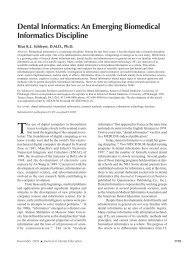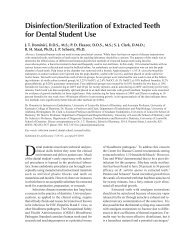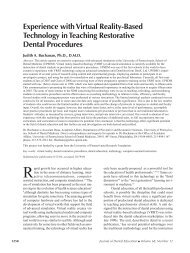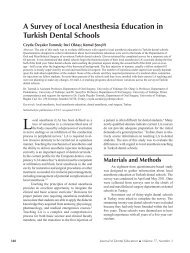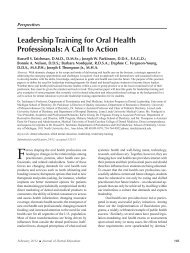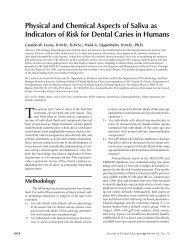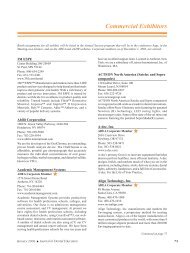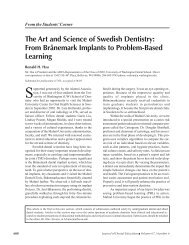List of Poster Presentations - Journal of Dental Education
List of Poster Presentations - Journal of Dental Education
List of Poster Presentations - Journal of Dental Education
Create successful ePaper yourself
Turn your PDF publications into a flip-book with our unique Google optimized e-Paper software.
<strong>Poster</strong> Abstracts<br />
102. Noncognitive Predictors <strong>of</strong> Failure in <strong>Dental</strong> School<br />
Stark, Alan M., Temple University School <strong>of</strong> Dentistry, Deem,<br />
Lisa, Temple University School <strong>of</strong> Dentistry, Stark, Mary Jean, Manor<br />
College <strong>Dental</strong> Hygiene Program<br />
The purpose <strong>of</strong> this research is to determine if data from<br />
noncognitive domains are useful in predicting failure in dental school.<br />
Educators, who sit on the admissions committee <strong>of</strong> a dental<br />
school, constantly wrestle with the question: If admitted, will this<br />
student pass all courses? The admissions process consists <strong>of</strong> a careful<br />
review <strong>of</strong> cognitive credentials <strong>of</strong> prospective candidates, including<br />
consideration <strong>of</strong> total undergraduate grade point average (UGPA) and<br />
scores on the <strong>Dental</strong> Admissions Test (DAT). These two cognitive<br />
criteria compose the majority <strong>of</strong> the data used to determine which<br />
candidates were <strong>of</strong>fered admission to dental school. Each year, however,<br />
a number <strong>of</strong> students fail to make adequate progress, and are required<br />
to remediate a course, repeat a year <strong>of</strong> dental school or are asked to<br />
leave school. Why do some students fail to make adequate progress?<br />
The purpose <strong>of</strong> this research is to examine noncognitive domains (as<br />
defined by the Learning Assessment and Study Skills Inventory,<br />
Weinstein, Schulte & Palmer, 1987) to determine if the data provided<br />
enhance the ability to correctly classify students at Temple University<br />
School <strong>of</strong> Dentistry into one <strong>of</strong> two groups: those who pass and those<br />
who fail (N=346). Discriminant Analysis (DA) was used to interpret<br />
the data. DA is a robust statistical tool that allows the researcher to<br />
evaluate two objectives: assess the adequacy <strong>of</strong> classification <strong>of</strong> students<br />
(descriptive function), and assign students to one <strong>of</strong> two groups<br />
(predictive function). It is apparent from the analysis <strong>of</strong> the data using<br />
DA that scores in noncognitive domains have the ability to increase the<br />
strength <strong>of</strong> agreement when classifying participants in this study into<br />
one <strong>of</strong> two groups: those who pass and those who fail. This research,<br />
therefore, establishes a new paradigm for evaluating candidates for<br />
admission to Temple University School <strong>of</strong> Dentistry.<br />
This study confirms the assertions <strong>of</strong> numerous authors that<br />
cognitive tests provide “threshold” criteria for admission to graduate<br />
training. These authors contend and this study confirms that, once<br />
the threshold criteria are met, noncognitive data are useful in the<br />
decision to admit candidates to dental school.<br />
103. Remote <strong>Dental</strong> Consultation: Consumer<br />
Perspectives<br />
McGee, M K., University <strong>of</strong> Pennsylvania School <strong>of</strong> <strong>Dental</strong><br />
Medicine, Stewart, Denice CL., Oregon Health & Science University<br />
School <strong>of</strong> Dentistry, Stewart, Jeffery CB, Oregon Health & Science<br />
University School <strong>of</strong> Dentistry, Artz, Noam, University <strong>of</strong><br />
Pennsylvania School <strong>of</strong> <strong>Dental</strong> Medicine, Galbally, James F.,<br />
University <strong>of</strong> Pennsylvania School <strong>of</strong> <strong>Dental</strong> Medicine, Fonseca,<br />
Raymond J., University <strong>of</strong> Pennsylvania School <strong>of</strong> <strong>Dental</strong> Medicine<br />
Purpose: Determine and describe consumer perspectives and<br />
acceptance <strong>of</strong> an Internet-accessible, asynchronous remote dental<br />
consultation system (RDCS).<br />
Significance: Increasing access to specialty consultation may<br />
be <strong>of</strong> clinical value to dental consumers and expand access to dental<br />
school faculty expertise; however, little is known about consumer<br />
acceptance <strong>of</strong> Internet-based dental consultation.<br />
Methods: A remote dental consultation system for dentists has<br />
been developed and tested with practitioners with overall positive<br />
results. To assess the perspective <strong>of</strong> dental consumers, patients <strong>of</strong><br />
both a school-affiliated provider network and <strong>of</strong> the dental school<br />
participated in surveys and discussion. Volunteers completed a prediscussion<br />
survey, participated in a guided discussion, and completed<br />
a post-discussion survey.<br />
Results: Twenty-six consumers participated in pre/post surveys<br />
and the discussion. Key findings include: 1. When asked how much<br />
time would need to be saved to make Internet consultation worthwhile<br />
vs. traveling to a specialist, 42% indicated 1 hour. 2. In pre/post comparisons, consumer<br />
acceptance declined after the discussion, although they remained very<br />
positive overall: e.g., agreement with “letting my dentist use the<br />
Internet to send my records to another dentist is a good idea” declined<br />
from 89% to 81% (pre mean 1.62, post-mean 1.88, scale 1=strongly<br />
agree to 5-strongly disagree, pr’d t-test, p=0.03). 3. In discussion,<br />
two main reasons for the decline in consumer confidence were noted:<br />
a. significance <strong>of</strong> cost saving - saving half the cost increased agreement<br />
for most participants, and b. fear <strong>of</strong> being “HMO’s out <strong>of</strong> service”,<br />
and loss <strong>of</strong> personal interaction with the specialist. However,<br />
participants indicated their views would be no different for an Internet<br />
based consultation than for a mailed consultation.<br />
Consumers have concerns about Internet based consultation but<br />
are overall positive about the potential.<br />
104. Assessment <strong>of</strong> the Need for a <strong>Dental</strong> Hygiene<br />
Master’s Program<br />
Testerman, Deborah L., Texas Woman’s University<br />
The purpose <strong>of</strong> this study was to evaluate the need for a dental<br />
hygiene master’s degree program by surveying currently licensed<br />
dental hygienists.<br />
There is a continued growth <strong>of</strong> dental hygiene programs in the<br />
U.S. and a limited number <strong>of</strong> dental hygiene master’s degree programs<br />
to staff this need. The purpose <strong>of</strong> this study was to evaluate the need<br />
for a master’s degree program by surveying currently licensed dental<br />
hygienists. An eleven-item questionnaire was used to survey 263<br />
dental hygiene graduates from a baccalaureate program. The<br />
questionnaire consisted <strong>of</strong> information on demographics, desire to<br />
pursue a higher education degree, and future educational needs. Of<br />
the surveys returned, 48% (N=127) had been completed for analysis.<br />
Data analyses, including frequencies and percent were conducted in<br />
SPSS. Common themes were tallied for answers to open ended<br />
questions. The demographics proved to be consistent with the<br />
population. Twenty-one percent <strong>of</strong> the respondents reported that they<br />
would pursue a graduate degree. Common reasons reported included:<br />
advancing the dental hygiene pr<strong>of</strong>ession, personal education, and<br />
preparation for teaching. The respondents listed the following four<br />
interdisciplinary courses they would like to have <strong>of</strong>fered: business<br />
(49.6%), computer science (41.7%), community health (41.7%), and<br />
geriatrics (41.7%). Twenty-two percent <strong>of</strong> respondents reported that<br />
they were likely to change careers in the next five years. Reasons<br />
cited were physical demands, stress, and burnout. Personal goal<br />
(65.4%) is the primary reason to pursue a master’s degree.<br />
Respondents stated that a breadth <strong>of</strong> subjects, diversity <strong>of</strong> students,<br />
level <strong>of</strong> family responsibilities, time, money, and age are issues. If a<br />
graduate degree were pursued the respondents would like to have a<br />
variety <strong>of</strong> courses to choose from and would need flexibility and<br />
creative scheduling. Finally, 57.5% <strong>of</strong> the respondents believed that<br />
obtaining a graduate degree in dental hygiene would increase their<br />
career opportunities. The dental hygiene pr<strong>of</strong>ession needs to pursue<br />
interdisciplinary, dental hygiene <strong>of</strong>ferings to address needs <strong>of</strong> students<br />
and the pr<strong>of</strong>ession.<br />
If a graduate degree were pursued the respondents would like<br />
to have a variety <strong>of</strong> courses to choose from and would need flexibility<br />
and creative scheduling. Finally, 57.5% <strong>of</strong> the respondents believed<br />
that obtaining a graduate degree in dental hygiene would increase<br />
their career opportunities.<br />
105. Presenting <strong>Dental</strong> Careers to High School Students<br />
Thomas, Denee, University <strong>of</strong> Texas Health Science Center at San<br />
Antonio <strong>Dental</strong> School, MacDougall, Mary, University <strong>of</strong> Texas Health<br />
Science Center at San Antonio <strong>Dental</strong> School<br />
290 <strong>Journal</strong> <strong>of</strong> <strong>Dental</strong> <strong>Education</strong> ■ Volume 66, No. 2



